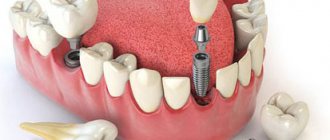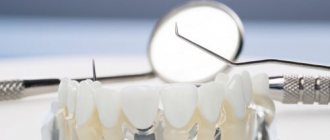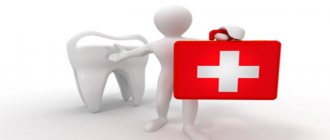Modern dentistry is undoubtedly the latest generation of implantation. Science and technology in this area are ahead of their time; the development of implantology can be compared to space developments. Continuous study of a huge number of clinical cases, analysis of results, implementation of innovative solutions, improvement of materials and types of implants has already made it so that modern dental implantation is completely painless, safe and allows you to restore an entire row of teeth even in one visit.
Modern dental implantation
Dental restoration using implants began in the mid-twentieth century. The metal rod installed in the jawbone has changed over time, and new methods of its installation have appeared. Outdated plate implants are no longer used. Doctors have moved away from the intramucosal, superiosteal method and some others. Nowadays, new generation dental implants are artificial roots made of titanium alloy, which are biocompatible with the human body, do not cause allergic reactions, are durable and reliable for chewing loads. They play the role of real roots, preventing the atrophy of bone tissue that would inevitably occur in the place of lost teeth. And new implantation protocols make it possible to quickly solve the problem of the absence of one or all teeth, without preparing healthy teeth and even avoiding sinus lifting and increasing the volume of bone tissue in case of its deficiency.
Dental restoration forever!
Installation of a two-stage implant ROOTT (Switzerland) - RUB 27,000. 32,000 rub.
PIC-Optima as a replacement for titanium implants
PIK-Optima is a new biological polymer material from which it is possible to produce implants that are not inferior in their characteristics to titanium analogues. This material was created by French scientists. In 2005, a pilot batch of artificial dental roots was produced from it for the first time. Implants made from PIC-Optima biopolymer have the following advantages:
- very long service life;
- maximum similarity of the material to the bone structure of the jaw;
- the material does not cause an allergic reaction in patients;
- high resistance to chemical influences.
It is also noteworthy that PIK-Optima can be used both to strengthen soft tissues and to strengthen and even replace bone tissue in the oral cavity. Moreover, unlike titanium alloys, this material is very plastic. This allows implants to be manufactured to a given size as accurately as possible, and the flexibility of the material does not provoke bone tissue destruction.
Modern methods of dental implantation
The dental clinic can offer the patient atraumatic, fast and effective modern implantation methods.
Express implantation
(simultaneous implantation). The method of implanting a titanium pin directly into the socket of an extracted tooth is used. Advantages of the one-stage flapless method:
- there is no need to cut the tissue, suturing it, which means less time will be spent on healing and removal of sutures;
- the non-traumatic nature of the operation, which is morally easier for a person to bear;
- installation lasts up to 15 minutes.
In what cases is this transgingival method of modern dental implantation suitable:
- in the absence of one or all teeth on the upper or lower jaw;
- There is a time limit for recovery (it must be done urgently).
In addition, there should not be severe inflammation of the gums and insufficient bone tissue (consultation with a doctor is necessary to resolve these issues).
Implantation with immediate loading
(one-stage implantation). Just a couple of decades ago, after implantation, it was necessary to walk without a visible tooth, without a crown or prosthesis, for the entire period of osseointegration (3-6 months). Which, naturally, caused terrible psychological discomfort in any patient. The latest generation of implantations allows you to immediately install an adaptive prosthesis. A person leaving the dentist's office can smile, speak without defects and eat normally. During the entire period of engraftment of the titanium pin, its fusion with tissues and blood vessels, a lightweight temporary prosthesis allows you to get used to the presence of the orthopedic structure in the mouth and not experience discomfort in everyday life.
Zirconium dioxide implants
Implants made from zirconium dioxide successfully replace metal structures. In addition, zirconium implants are implanted into bone tissue much faster than titanium ones. Zirconium dioxide is highly resistant to mechanical loads, both static and dynamic. It is quite easy to process and integrate into the jaw bones.
The advantages of the material include:
- high strength;
- long service life;
- no allergic reaction in patients.
Zirconium dioxide, unlike titanium alloys, does not release metal microparticles into the soft tissues of the oral cavity.
Indications:
- absence of one, several teeth or complete edentia.
Dental implantation using a surgical template
. The use of 3D modeling helps the doctor accurately plan the operation, eliminating all risks and undesirable consequences. The modern method of implantation using a surgical template is the key to the successful work of an implantologist and orthopedist.
After a CT (computed tomography) scan, the doctor outlines the location of the implants in the program, which he then works with to decide at what angle and what type of implant to install. And the technician is already preparing to make temporary crowns and prostheses, which will be fixed on the day of implantation.
Implants with tapered abutment connection
Such structures are non-demountable. Their conical abutment ensures uniform load over the entire area of the implant, which dramatically reduces the likelihood of root loosening while chewing solid food. Such implants can be installed below the level of the cortical bone, in the area of which there is very little blood circulation.
The advantages of this technology are:
- monolithic design;
- uniform load distribution over the entire area of the implant;
- impossibility of penetration of pathogenic microorganisms to bone tissues:
- fast and very tight implantation of the implant into bone tissue;
- the technology does not interfere with normal blood circulation in the oral cavity;
- natural appearance;
- long service life.
Indications:
- absence of several teeth or complete edentia;
- a complex clinical case that requires a particularly careful approach.
Implantation
All-on-4 and All-on-6
. Modern dental implantation “All on four” or “All on six” allows you to reduce the financial burden of restoring the entire dentition. By implanting only 4 or 6 titanium rods, you can install a complete denture on the jaw with 10-12 artificial crowns. Installing an implant instead of each tooth would require more money and time.
Algorithm for immediate implantation
This method is preferable to the classical one if the following conditions are met:
- the tooth in place of which an artificial root is to be implanted has not yet been removed;
- the condition of the bone tissue allows for the implantation of a pin.
The protocol for immediate implantation is as follows:
- the preparatory stage is identical to that of the classical method;
- removal of the element to be replaced and installation of the implant in the vacated canal;
- fixation of a temporary crown;
- process of osseointegration;
- installation of a permanent prosthesis.
Indications:
- absence of most teeth or complete edentia;
- inability to wear a removable lamellar denture.
This modern implantation method allows people with removable dentures to securely fix it.
Complex implantation
. “All inclusive” in dental treatment. In one visit to the dentist, teeth are removed (if necessary) and an implant is inserted. A method for immediately restoring multiple teeth. Prosthetics on 6-12 implants with a fixed prosthesis.
Rehabilitation after implantation
The main rehabilitation after the procedure is the implantation. On average, this process takes 4-6 months, but much depends on the implants used and the characteristics of the patient’s body. Everything here is individual. During the rehabilitation period, the patient must strictly follow the recommendations of the attending physician and regularly visit the dental office to monitor the process of osseointegration of the implant. Violation of the doctor’s recommendations may negatively affect the condition of the installed orthopedic structures or lead to health problems.
Indications:
- impossibility of two-stage implantation;
- absence of 3 teeth to complete absence;
- urgency of recovery.
Resmile
. Implantation technology without cuts or sutures. The transgingival method of implanting a titanium root is atraumatic, healing occurs quickly. The combination of implants from one system increases the success rate and minimizes complications. This is facilitated by a titanium-based ceramic composite prosthesis, which is installed on the 4th day and does not require replacement subsequently; it is permanent.
The latest achievements of Israeli doctors
Israeli specialists perform the implantation of an artificial root carefully and consistently; the operation can take from 4 to 8 hours. Anesthesia is administered using Sleeper One technology, which involves a slow injection of anesthetic. This makes the procedure comfortable for the patient. The effect of the medicine begins after 40 minutes and leads to an absolute blocking of the sensitivity of the jaw. The method is safe and requires a minimum of time and money.
The rehabilitation period after implantation in Israeli clinics takes three days in the hospital. The patient must remain in a state of complete rest and follow the specialist’s recommendations. The medication course is selected individually. It usually includes anti-inflammatory and antibacterial drugs.
New generation of dental implants
Implant manufacturers are constantly researching and developing new types of dental implants. By studying numerous clinical pictures from the practice of doctors, they create new types of threads, improve the alloy, and change the method of processing the surface of the product.
New generation dental implants:
- Compression implants. The very tight contact of titanium and tissue promotes rapid osseointegration.
- Multi-units with a rotating abutment head, screw fastening for fixing the prosthesis with screw fixation.
- Basal implants are placed where there is critically little bone tissue. Their implantation occurs in deeper, dense layers.
The titanium alloy is being improved, and the grinding and processing of the implant surface takes place in several stages. This is sandblasting and etching. The main thing is to achieve the necessary roughness of the root part of the implant for successful survival and cleanliness, the absence of traces of organic matter during production. The necks are made smooth to prevent the accumulation and reproduction of bacteria on them. Every nuance is taken into account. And the creation of a wide range of implants allows the doctor to comprehensively use different types of artificial roots within one operation.
Modern systems have a warranty of 25-50 years, and many manufacturers provide a lifetime warranty. The survival rate of implants takes from three months to six months, and the success of osseointegration of new generation dental implants reaches 98.5%.
New developments by Malaysian scientists
Scientists from the Department of Restorative Dentistry at a Malaysian university have developed a new type of implant designed for older age groups of patients. Their work was based on the creation of a special bioceramic coating made of magnesium silicate for the rod and abutment, which will ensure rapid fusion with bone tissue.
The researchers also developed a new method for making titanium structures. It involves microwave sintering of the implant after coating it with titanium powder. This favors rapid implantation, improvement of the aesthetic effect, as well as the quality of implantation.
The leader of a group of Malaysian scientists, Alirez Yagubi, believes that the creation of personalized dental systems is a promising area of biotechnology. Each patient is unique and requires an individual approach.
Development continues, clinical trials of new implants are being conducted. In the future - increasing the service life of structures, creating high-quality products accessible to all categories of the population.
Alternative Methods
You can restore the integrity of the dentition using:
- removable prosthetics. It is inexpensive and can immediately replace all lost teeth. But it takes a long time to get used to such voluminous structures; at first they can cause a gag reflex. For more reliable fixation, additional means such as Corega are often used to prevent the prosthesis from accidentally falling out. Aesthetics are poor, and tissue atrophy progresses inexorably. With prosthetics on implants this is impossible.
- prosthetics with a bridge supported by adjacent teeth. In this case, the supporting teeth grind down and become weaker. With constant chewing load, such structures may collapse over time.
- crowns If the tooth root is preserved, it can be restored with a crown. If the root is destroyed, then the only options left are single implantation or a bridge;
- classical implantation. A two-stage protocol involves installing a root-shaped implant, waiting for it to engraft into the bone, and only then fixing the permanent prosthesis. This is a long process (from 3 to 6 months), during which the titanium rod is completely osseointegrated into the jaw bone.
Japanese scientists create implants similar to natural teeth
Creating an artificial organ biologically identical to a natural one is a difficult task. Japanese scientists under the leadership of Professor Takashi Tsuji coped with it “excellently.” They created a biohybrid dental implant that completely recreates the structure and function of a natural tooth. The development is based on coating a conventional titanium implant with hydroxyapatite and stem cells from dental follicles.
Studies have shown that after installation of the implant, active regeneration of periodontal tissue occurs and it begins to function like a natural tooth. Capable of feeling pain and responding to mechanical stress.
The work of scientists is still ongoing; now the material is not yet used for dental purposes . The biohybrid implant is a great achievement, which in the near future will be used to restore lost teeth.
Price
Modern dental implantation is more expensive than prosthetics. The cost of treatment depends on several factors:
- chosen method;
- use of a surgical template;
- number of implants;
- company manufacturer;
- material of prosthesis, crown;
- qualification of an implantologist.
For example, the price of one-stage implantation with a temporary crown is about 40,000 rubles, the All-on-4 technology of one jaw with an adaptive prosthesis will cost from 190,000 rubles, one-stage implantation with complete edentia of one jaw on 6 compression implants and a temporary prosthesis - in the region RUB 265,000 The cost item may increase due to additional diagnostics and prosthetic materials.
Stages of implant installation and timing
The implantation procedure can be one-stage or two-stage. With a one-step procedure, all steps can be completed in one day, which is why it is sometimes called express implantation. But it still takes several months for the implant to fully heal, during which you cannot put full load on the artificial tooth. Another feature of one-stage implantation is the installation of a one-piece structure (implant + abutment), so if necessary, replacing it will present a certain difficulty.
Two-stage implantation includes the installation of an implant, and after a certain period (3-6 months) a permanent crown is placed on it. This requires several visits to the dentist, but in many cases this process is more justifiable for medical reasons. It is less risky and allows for more careful monitoring of the condition of the oral cavity at all stages of treatment.
The installation stages and timing of dental implantation depend on the specific situation, the anatomy and physiology of the patient, his financial capabilities, as well as the treatment plan chosen by the doctor.
It is also necessary to understand that in addition to the implantation procedure itself, diagnostics are also required (X-rays and tomograms, blood tests), treatment of caries on all teeth, removal of teeth that cannot be restored, taking impressions and making crowns, and in some cases, bone grafting. All this also takes time and sometimes significant time.
Preparation for implantation: diagnostics and modeling
Before implantation, you must visit the doctor at least 2 times. The initial consultation allows the implantologist to examine the oral cavity, get acquainted with the patient’s wishes, assess the prospects for treatment, and also take the necessary x-rays and tomography showing the condition of the jaw bone tissue and the presence of externally invisible features and pathologies of the dentition.
After this, the doctor prescribes:
- laboratory tests (tests),
- consultations with related specialists (at least an orthopedist and anesthesiologist, and in the presence of chronic diseases - specialized doctors: a cardiologist, an endocrinologist),
- sanitation of the oral cavity (treatment of caries and other diseases, professional cleaning, as well as removal of teeth that cannot be treated),
- correction of existing dentures and crowns,
- if necessary, bone grafting.
After completing all the established measures and removing obstacles to implantation, the doctor checks the condition of the oral cavity and sets a date for the operation, concludes an agreement, and talks about how to prepare for the operation.
Installing implants is only half the battle. After this, it will be necessary to install crowns on them. To do this, the patient's jaw is modeled. Photometry is performed - photographs of the face are taken in different positions, the facial arches are studied, then the characteristics of the bite are studied, and the work of the temporomandibular joint is examined. After this, a 3D model of the jaw is created, on which the doctor plans the installation.
Surgery: installation of implant and healing abutment
How long does it take to install an implant? The operation itself can be performed in different ways, depending on the choice of method, type of material, and other reasons. If we talk about the most common case of two-stage endosseous implantation, it is carried out as follows: the doctor makes incisions in the gum, drills a hole in the jawbone and installs a root-shaped screw implant, after which the gum is sutured around the implant, completely covering it. After a few days, the doctor removes the stitches. After 3-6 months, the gum is opened and a gum former is placed on the implant, and after another 2-3 weeks - an abutment and crown.
Incisions can be made not with a scalpel, but with a laser - it is believed that this is less painful (the dose of anesthetic can be reduced), produces less bleeding, and there is no need for stitches after laser implantation. But this method significantly increases the cost of implantation (by 30-60%).
Orthopedics: prosthetics on implants
This is the final stage of dental restoration using implantation, which reproduces the functionality and aesthetics of the dentition. Orthopedic structures of 3 types can be installed on implants: a single crown, simulating one missing tooth, a bridge prosthesis, replacing several lost teeth in a row, and a complete prosthesis, simulating the entire dentition.
According to the stage at which orthopedic structures are installed that transfer the load to the implant, there are:
- implantation with immediate loading - the crown is placed immediately, immediately after the operation, or within 72 hours after it, this is the fastest method, but the risk of material rejection is maximum here,
- implantation with early loading - the crown is placed within 4-6 weeks after implantation, with a temporary crown usually placed, which is replaced with a permanent one a few months later,
- implantation with late loading is the most traditional method, in which the risk of rejection is minimal, since the chewing load, which can damage the fusion of the implant with the bone tissue, is transferred to the tooth after the material has engrafted.
With two-stage implantation with late loading, the risks are minimized, since the implant rests for several months without chewing load, and the likelihood of infection is also minimal due to the fact that the implant support area is hidden under the gum.
When making prosthetics, it is imperative to take into account the compatibility of materials in order to eliminate the possibility of breakage of the prosthesis, as well as to hide the possible transmission of the supporting structure through the translucent material of the crown.
Where to go for the latest generation of dental implants
Only dental clinics with technologically advanced diagnostic and surgical equipment and highly qualified staff can offer a choice of modern methods of dental implantation and a guarantee for their work.
The table shows several Moscow clinics where you can restore a beautiful smile in an advanced way. We advise you to find out the cost and current promotions directly on their websites.
| dental clinic | Website |
| Center for Dental Implantology ROOTT (RUTT) | https://dentalroott.ru |
| Dentum dentistry | https://dentumclinic.ru |
| City-Dent | https://city-dent.rf |
| The president | https://www.prezi-dent.ru |
| Center Family Dentistry | https://family-dental.ru |
The main advantages of two-stage implantation
1. Traditional technology shows the highest rates of successful implant survival. The implantologist, by opening the gum and making an incision on the bone, gains high-quality access and visibility necessary for strong fixation of the implant.
2. Two-stage implantation is applicable to solve the problem of both single and multiple dental defects.
3. The ability to place a crown made of any material on the implant.
4. The patient can choose, together with a specialist, implants for the operation - budget or premium, depending on his financial capabilities.
5. The use of a gum former makes it possible to obtain high aesthetics of the restoration. The crown will look as natural as possible.
Despite the many advantages of traditional implantation, there are also a number of disadvantages that you should know about in advance.
What does the cost consist of?
At each stage, a specialist needs to carry out difficult work:
Preparation for surgery requires the doctor to have precise knowledge of the anatomical structure of the jaw. In addition, the cost of treatment includes computed tomography and other procedures to obtain the necessary information about the clinical situation.
Implantation is a complex process that requires certain skills. A good implantologist is worth his weight in gold - only a trained specialist will be able to install implants that will last for the rest of your life. Such services cannot be cheap. The most advanced implantation technologies require high costs, but guarantee excellent results.
Installation of prostheses. The cost will largely depend on the material chosen for the prosthesis. Metal, metal ceramics and zirconium dioxide have different costs.
Is it possible to save money on implantation?
Implantation is a complex operation, so it’s definitely not worth chasing offers from clinics that promise to implant implants at a cheap price. It is wiser to pay attention to offers with promotions for implantation, but even here we recommend that you exercise caution. Always find out which services are included in the promotion and which you will have to pay separately. To find out this information, be sure to visit the clinic - this will give you the opportunity to independently assess the level of equipment in dentistry.
Be sure to study reviews about the clinic on the Internet, find out what reputation it has in the dental services market. It is advisable to inquire about the qualifications of doctors working in dentistry. Another important point is that in a clinic that values its reputation with patients, before performing any manipulations, a detailed treatment plan is always drawn up, which indicates all costs.
If you are not given such a plan, this is a serious reason to be wary and look for another dentistry option for dental implantation. Detailed collection of information about the service offered and the clinic will allow you to avoid wasting time, money and eliminate risks to your own health. Implantation carried out with errors in the protocol, using low-quality materials and implants is fraught with implant rejection and the onset of an inflammatory process. Eliminating such consequences will be not only unpleasant, but also very costly.
After a successful dental implant surgery, you can get back part of the money spent. Read our article “13% tax refund for dental treatment” Smart savings on implantation is the right choice of the clinic and implantologist who will conduct your treatment. The specialist will not only offer you the optimal method for dental implantation, but will also help you choose affordable or premium implants. Dental implantation is one of the services of our dentistry in Moscow - Vanstom. We guarantee high quality and safety of implantation, we are always ready to offer you an individual treatment plan taking into account your wishes and financial capabilities. For detailed consultation on dental implantation, visit our clinic, our address in Moscow: Moscow, Baumanskaya metro station, st. Bakuninskaya, 17/28.
Some disadvantages of two-stage implantation
1. It is worth preparing for long-term treatment, during which you will have to visit the clinic several times.
2. In most cases, preliminary osteoplasty is required. Bone grafting operations are associated with additional costs and also increase the overall treatment period.
3. The procedure will be painful. The gum will be cut, and a hole will be drilled into the bone for implantation of a titanium screw. Naturally, anesthesia will remove discomfort during the operation, but during the recovery period you may feel discomfort for some time. However, it can be eliminated by taking medications that the implantologist will recommend to you.
The price of two-stage implantation will depend on the type of implantation system that will be chosen. Services for making a crown to complete the restoration, its installation, as well as additional procedures (osteoplasty, treatment of caries, sanitation of the oral cavity) are not included in the price of implantation; they will need to be paid separately.











